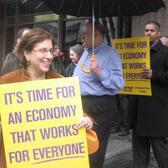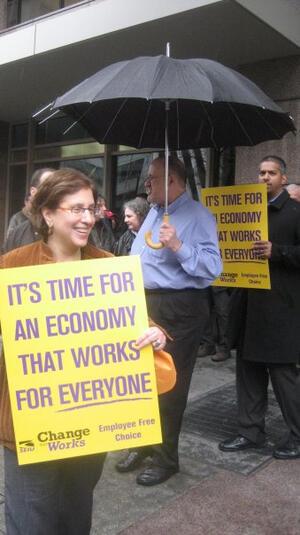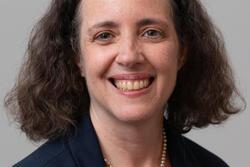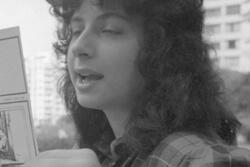Understanding the Past, Imagining the Future
Images and scenes etched in the minds of generations of Jewish activists--immigrant workers marching, sitting in, and striking; tear gas filling the air as riot police attack, beat and arrest union protesters; and battles with gangsters to free unions of mob domination. Freedom rides across the South, rabbis and religious leaders arrested in protests, and a generation of Jews--rank and file workers, organizers, and emerging leaders--swept up and inspired by a movement to win economic, racial, and social justice.
This isn’t a description of the turn of the last century when garment workers organized, it isn’t the 1930’s, the birth of the CIO and the New Deal, nor is it the civil rights, the feminist and anti-war movements of the 1960’s. This is Seattle in 1999 when union members, students, environmentalists, and progressive groups shut down the World Trade Organization in the “Battle in Seattle.” This is 2003 when undocumented immigrants, joined by civil rights leaders, rode buses and rallied all over the country and the south to demand citizenship. This is the successful battle to chase the mob out of the Teamsters in the early 1990’s.
These recent moments are etched in my brain because I lived them--being shot with a rubber bullet by police in Miami, watching body guards use mirrors to search for bombs that might have been planted under our car, experiencing the incredible bravery of undocumented workers risking deportation on the picket line, victories won by janitors, hotel and strawberry workers. This isn’t the labor and Jewish history of our grandparents, these are the battles of the last twenty years. And submerged in that history is the story of Jewish women, sometimes behind the scenes and sometimes in the front lines, who made a home in and helped remake the American Labor movement of the 1980’s and 1990’s and the early part of this century.
I grew up in an observant kosher home in Erie, Pennsylvania, a heavily unionized industrial town in the rust belt. In a town with few Jews, Judaism--its values, and social justice teachings--were central to our lives. And because there were so few Jews, and our family struggled financially, I always had this sense of being an outsider and needing to fight to make and find my place.
In 1974, when I went to the University of Wisconsin, I found a job to pay for college, as a state employee and clerical worker in a department where almost all the workers were women. I soon became involved in my new union, AFSCME, as a shop steward, and representative to the central labor council. In some ways, I lived three overlapping lives: student activist, worker/union activist, and feminist activist, radicalized by the woman’s movement in Madison. And it is these three experiences, infused with my Jewish identity, that launched the next thirty years of my life in the labor movement.
I left Madison when AFSCME hired me to start their community action program to build coalitions with community groups for AFSCME nationally, based on the idea that public services and the rights of public workers could only be won and protected if they benefited and had the support of the communities they were designed to serve. I became the Education Director for the Teamsters Union when Ron Carey became president as part of the anti-mob reform movement that was able to win the United Parcel Service, “Part time doesn’t work” strike. When John Sweeney became President of the AFL-CIO, I became the Director of Field Mobilization for the AFL-CIO, its largest department, with the goal of making labor a central player in supporting and building a broad based movement for justice in the country, launching the Union Cities campaign that reshaped the political and union life of cities like Los Angeles.
And each step of the way there were Jewish woman leaders. Vicky Saporta was the Organizing Director for the Teamsters Union. Karen Nussbaum and Debbie Schneider where founders of 9 to 5, a union focused on organizing clerical workers and immortalized in the Dolly Parton Film. There were young Jewish activists like Abby Levine, Jamie Rapaport, and Margie Klein who traveled on the Immigrant Workers Freedom Ride, and labor/ community strategists and leaders like Enid Eckstein, Ellen Golombeck, Benetta Mansfield, Merrile Millstein, and Amy Dean, head of the South Bay Labor Council and Labor Council Advisory Council. There is a generation of often unrecognized Jewish women Labor activists and leaders who transformed their lives and the lives of workers around them.
It is easy to fall into nostalgia or history for history’s sake, calling on people to recognize the incredible work that is often not well known about the role Jewish women played in recent labor battles. But I think it is important to ask hard questions about what we accomplished and what, if anything, it means for the future. Based on the continued decline of the labor movement, attacks on public sector unionism and growing economic inequality, there are two very different ways to look at this period.
Some may say that, despite noble battles and often heroic struggles, it was the last gasp of a dying labor movement. And that our attempt to revive the labor movement by joining it with the energy of student organizing, the passion of the women’s movement, and the moral clarity of the civil and immigrant rights movement failed. That unions and a whole wing of Jewish activism are a thing of the past, to be studied, maybe admired but irrelevant to the future.
But I think this is a misreading of what was accomplished and where we are in history. I think when we look back in ten or fifteen years, we will see this period as in some ways being ahead of its time and setting the stage for what a renewed labor and social justice movement needs to look like. The unions and movement of the future will not look like those of the past, but the seeds were planted, barriers swept out of the way, and the possibility of the movement we need to create was made possible by the actions we took at the end of the 20th century to build a new movement in the 21st century.
Each year my family holds the Sneiderman/Lerner Yom Kippur Break Fast at our home in Washington DC. This year close to 200 people joined us. As we said the prayers to welcome a sweet new year, and I looked out at young people from United Students Against Sweat Shops, the emerging activists in AVODAH, the new generation of community organizers toasting the new year with organizers and activists of another generation, I felt inspired, hopeful, and oddly confident that this generation can build on the work of the past to help build a movement to win victories. We can create a world that, even in our most idealistic moments, we never imagined.
To learn more about Jews and the Labor Movement, explore Living the Legacy: A Jewish Social Justice Education Project.








Thank you Marilyn for sharing your story with us and putting in the context of a tradition of powerful and courageous Jewish women who have fought for the rights of all people. Thank you for writing this and modeling what it means to claim our place. Blessings
Marilyn, What a wonderful story-- What a wonderful life you have made living our values and tradition. Thanks for the many ways you make this a better world.